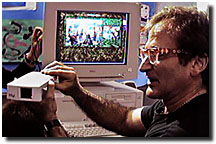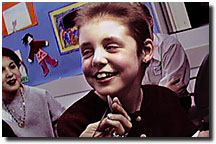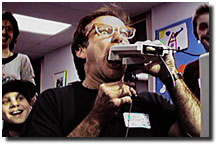|
||||||
|
||||||
 Robin Williams plays with patients at Mt. Sinai Medical Center in New York as well as patients in hospitals across the country thanks to Steven Spielberg's Starbright Foundation. As Lauren Alexanderson (right) discovered, laughter is the best medicine. (Photograph by Gregory Heisler)
|
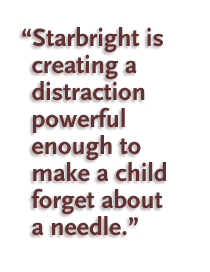
|
|
In Starbright World, a child recovering from a liver transplant in New York can run through the jungle with a friend from California. A boy undergoing chemotherapy in Boston can leave his room and fly to a castle in the sky. A little girl in Pittsburgh who needs machines to help her walk can turn herself into a knight in full armor and explore caves with a unicorn from Dallas. And on February 8th, sick kids around the country were invited to play in Starbrightís virtual playground with actor Robin Williams. Dr. Lonnie Selzer of UCLA says Starbright aims to ìcreate a distraction powerful enough to make a child forget about a needle.î And studies show that simple entertainment dramatically cuts the need for pain medication by young patients. Starbright -- with technology supplied by Sprint, Intel, Worlds Inc. and UB Networks-- helps these kids escape temporarily into magical worlds. Kids venture into Starbright World's four realms -- Tropical World, Cave World, Sky World, and the Building Zone -- with companions who have signed on from other hospitals. They choose cartoon-like characters called avatars to represent them in their explorations (when Spielberg plays, he assumes the role of E.T. from his own hit movie; during his Starbright visit, Robin Williams chose to be a wolf). When avatars encounter each other -- trekking through Tropical World's rain forest, say -- the kids controlling them can stop and talk via cameras and microphones at their computer terminals.
|
When Williams visited New York City's Mount Sinai Medical Center, he met 16-year-old liver-transplant patient Chrissy Oriol and a group of other young patients. But Chrissy ran into somebody even more interesting to her when the group went online: another child who had gone through the same operation and long recovery. "It was kind of, like, nice to talk to somebody my own age," someone who knows all about the pain and tedium of a four-month hospital stay, she says. Starbright World helped Chrissy vanquish sickroom blahs. "After I used this, I wasn't bored anymore," she says. "It was really, really cool."

|
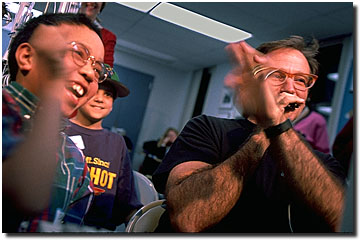
Robin Williams does his best to keep up a stream of sound effects while fending off a kung fu attack with encouragement from Daniel Bautista. (Photograph by Gregory Heisler)
|

http://www.starbright.org

|
Please direct all inquiries to: cyber24rs@aol.com
©1996, 24 Hours in Cyberspace Inc., All Rights Reserved.



